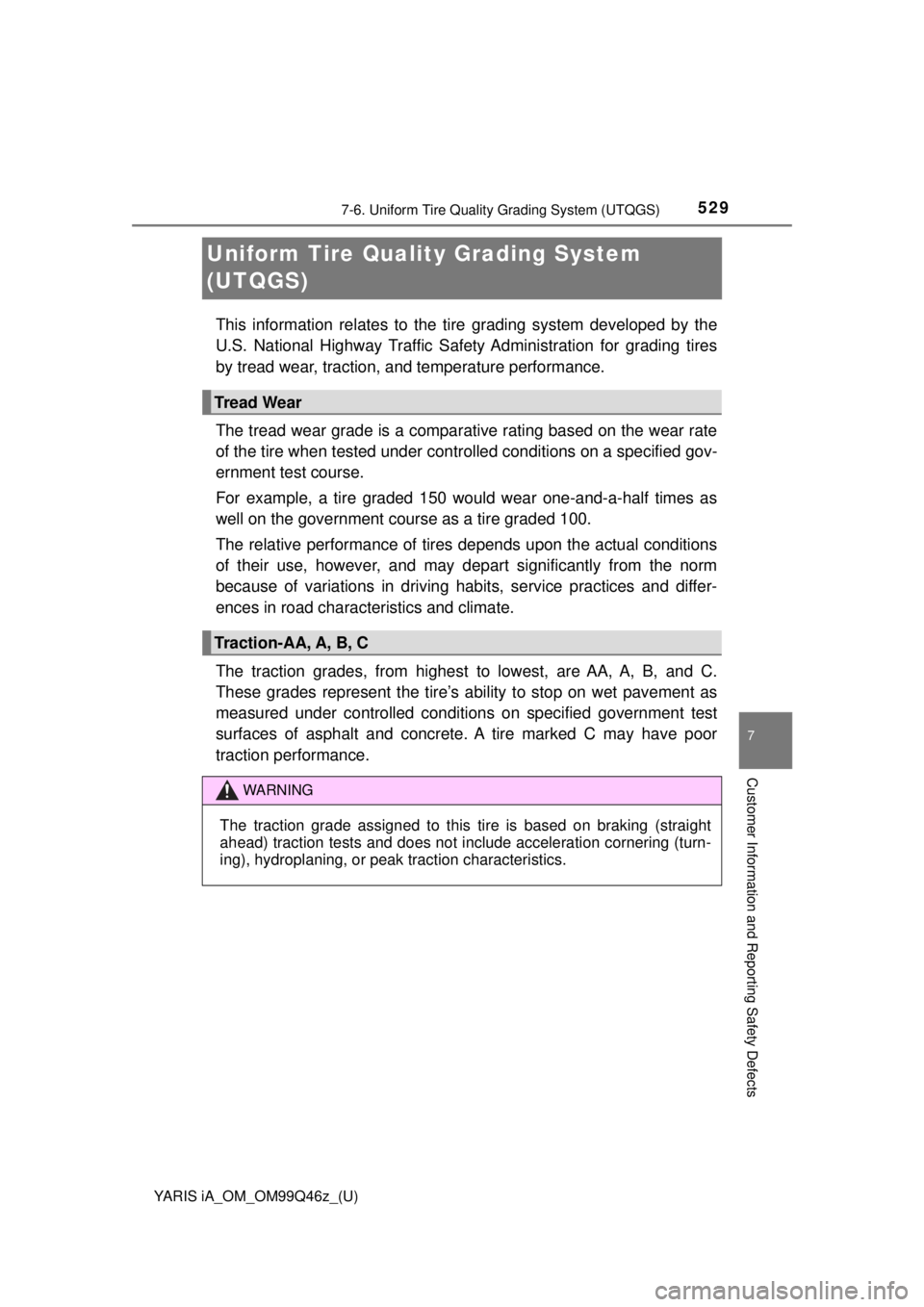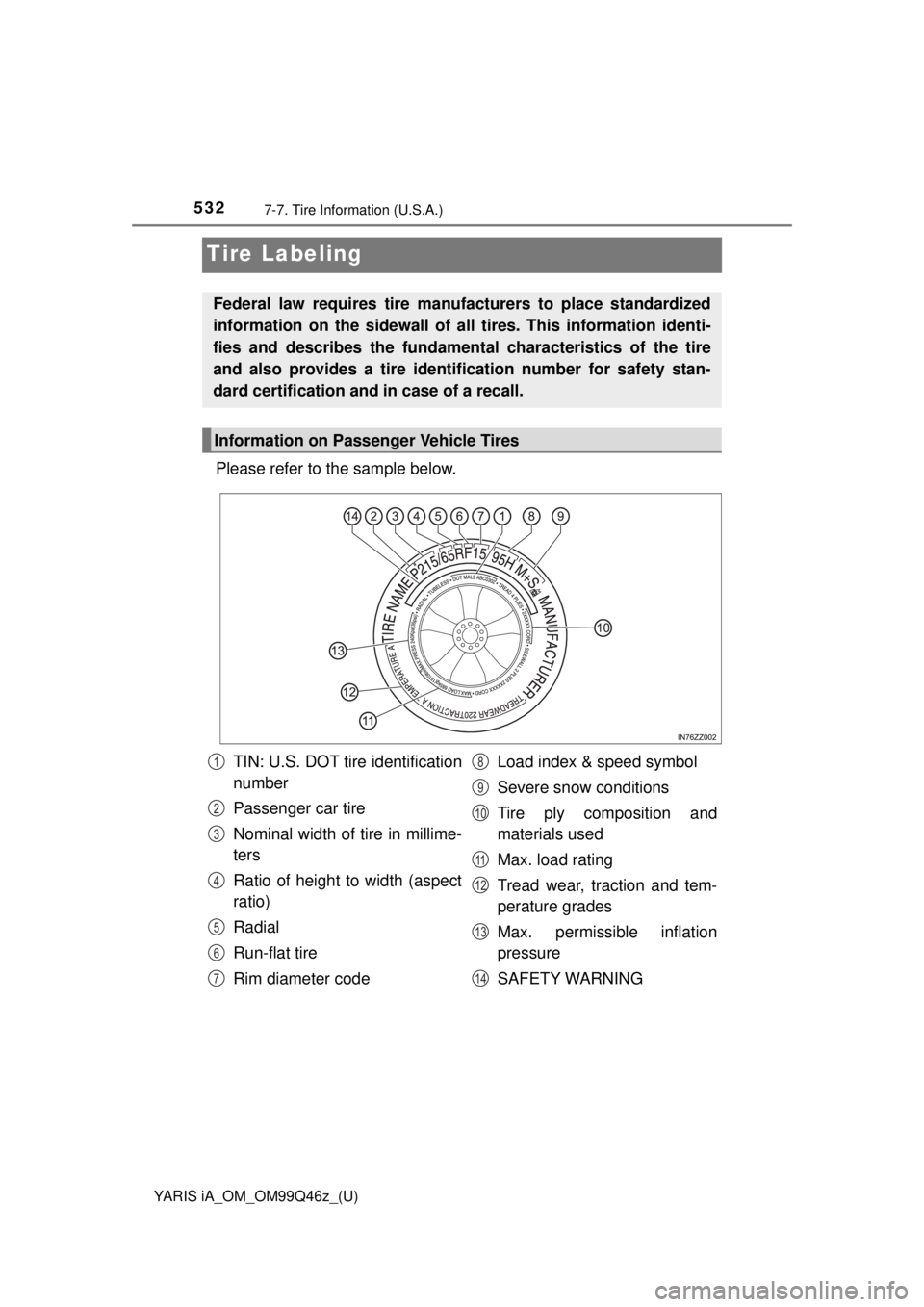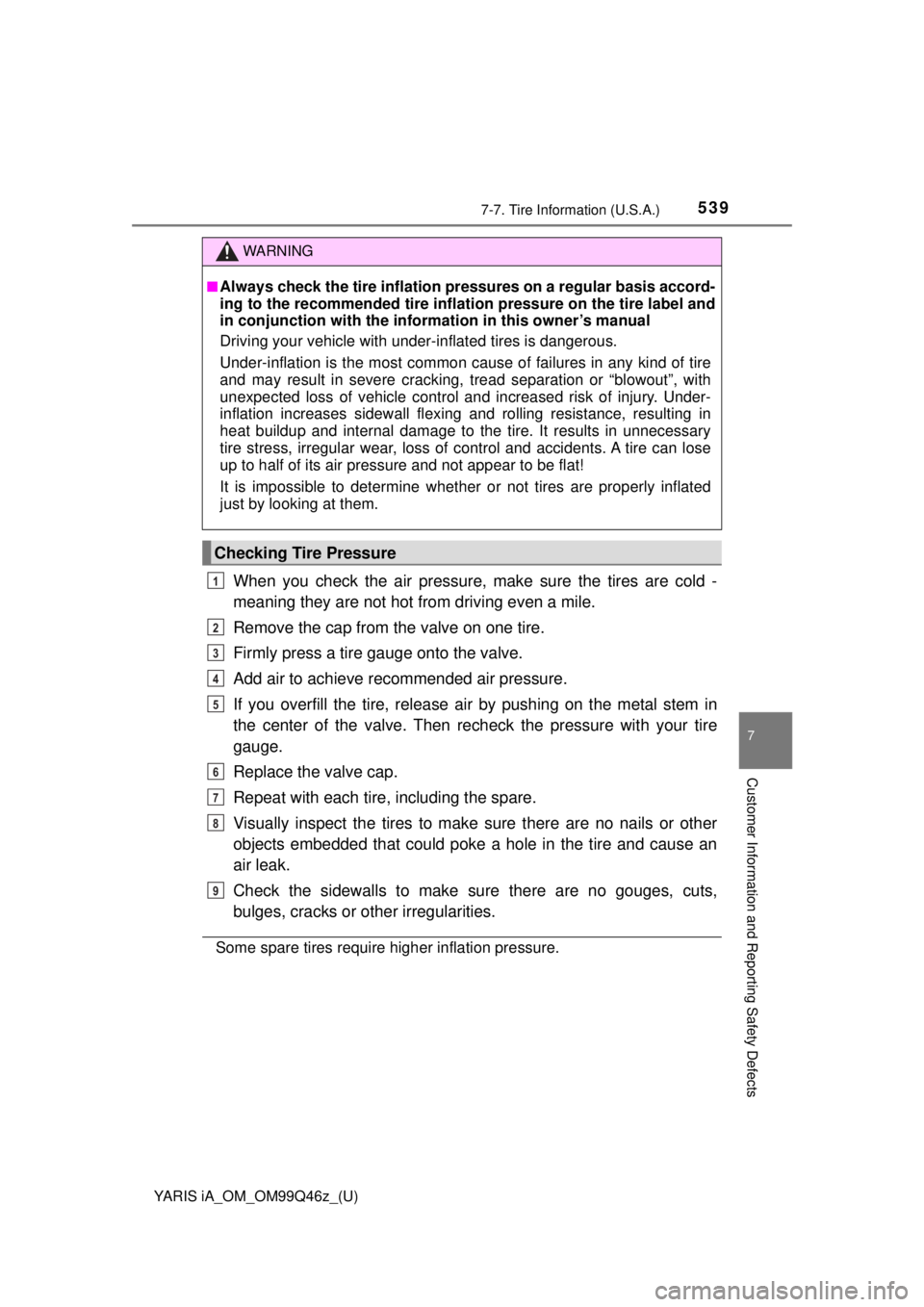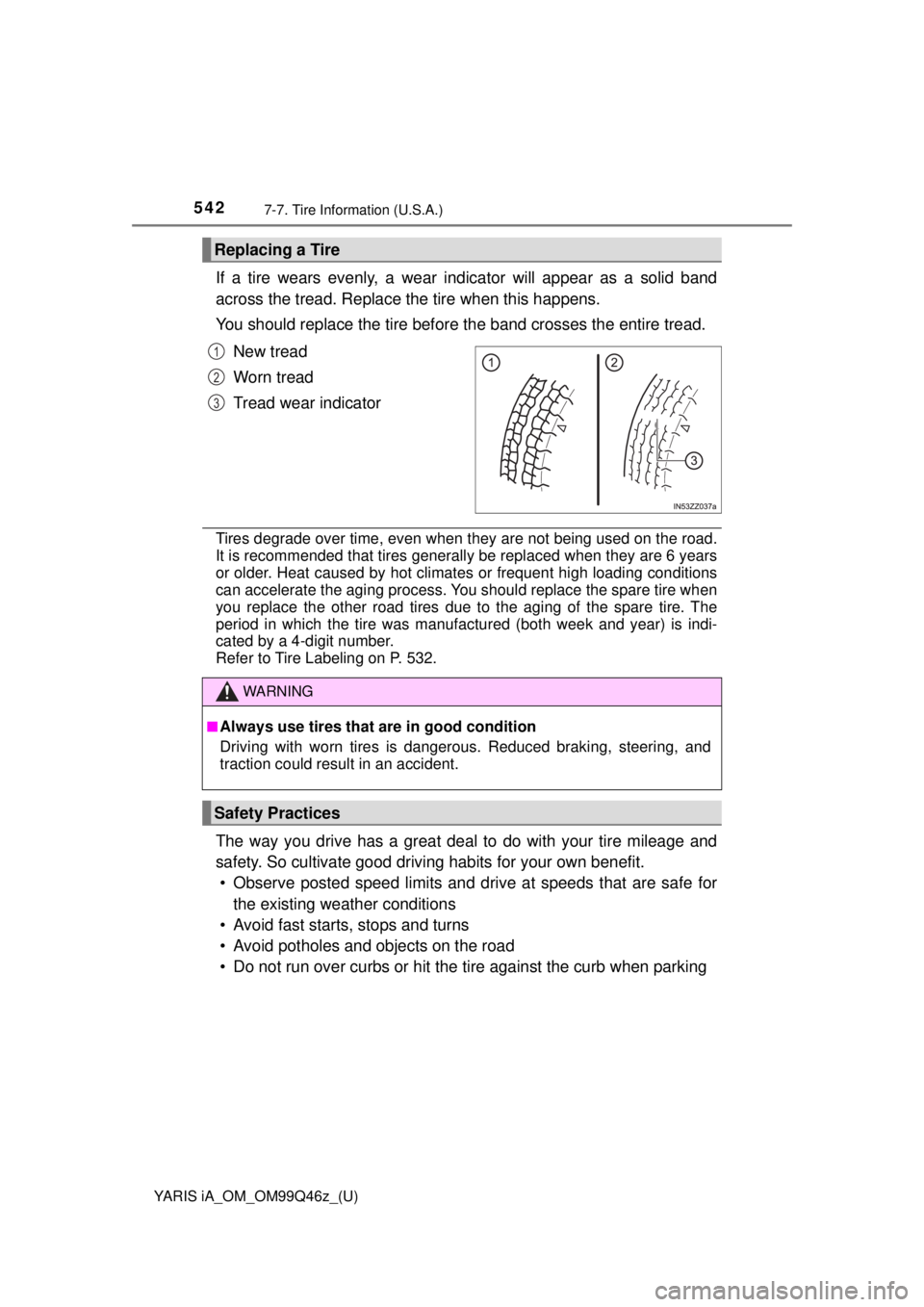2018 TOYOTA YARIS iA warning
[x] Cancel search: warningPage 525 of 576

525
YARIS iA_OM_OM99Q46z_(U)
7-3. Cell Phones
7
Customer Information and Reporting Safety Defects
Cell Phones Warning
WARNING
■Please comply with the legal regula tions concerning the use of com-
munication equipment in vehicles in your country
Use of any electrical devices such as cell phones, computers, portable
radios, vehicle navigation or other devices by the driver while the vehicle is
moving is dangerous. Dialing a number on a cell phone while driving also
ties-up the driver’s hands. Use of these devices will cause the driver to be
distracted and could lead to a serious accident. If a passenger is unable to
use the device, pull off the right-of-way to a safe area before use.
If use of a cell phone is necessary despite this warning, use a hands-free
system to at least leave the hands free to drive the vehicle. Never use a cell
phone or other electrical devices while the vehicle is moving and, instead,
concentrate on the full-time job of driving.
Page 529 of 576

529
YARIS iA_OM_OM99Q46z_(U)
7-6. Uniform Tire Quality Grading System (UTQGS)
7
Customer Information and Reporting Safety Defects
Uniform Tire Qualit y Grading System
(UTQGS)
This information relates to the tire grading system developed by the
U.S. National Highway Traffic Safety Administration for grading tires
by tread wear, traction, and temperature performance.
The tread wear grade is a comparative rating based on the wear rate
of the tire when tested under controlled conditions on a specified gov-
ernment test course.
For example, a tire graded 150 would wear one-and-a-half times as
well on the government course as a tire graded 100.
The relative performance of tires depends upon the actual conditions
of their use, however, and may d epart significantly from the norm
because of variations in driving habits, service practices and differ-
ences in road characteristics and climate.
The traction grades, from highest to lowest, are AA, A, B, and C.
These grades represent the tire’s ability to stop on wet pavement as
measured under controlled conditio ns on specified government test
surfaces of asphalt and concrete . A tire marked C may have poor
traction performance.
Tread Wear
Traction-AA, A, B, C
WARNING
The traction grade assigned to this tire is based on braking (straight
ahead) traction tests and does not include acceleration cornering (turn-
ing), hydroplaning, or peak traction characteristics.
Page 530 of 576

530
YARIS iA_OM_OM99Q46z_(U)
7-6. Uniform Tire Quality Grading System (UTQGS)
The temperature grades A (the highes t), B, and C, represent the tire’s
resistance to the generation of heat and its ability to dissipate heat
when tested under controlled conditions on a specified indoor labora-
tory test wheel.
Sustained high temperature can cause the material of the tire to
degenerate and reduce tire life, and excessive temperatures can lead
to sudden tire failure.
Grade C corresponds to a level of performance which all passenger
vehicle tires must meet under the Federal Motor Vehicle Safety Stan-
dard No. 109. Grades B and A represent higher levels of performance
on the laboratory test wheel than the minimum required by law.
These grades will be added to the sidew alls of passenger vehicle tires
over the next several years according to a schedule established by
the NHTSA and the tire manufacturers.
The grade of tires available as st andard or optional equipment on Toy-
ota vehicles may vary with respect to grade.
ALL PASSENGER VEHICLE TIRES MUST CONFORM TO THESE
GRADES AND TO ALL OTHER FE DERAL TIRE-SAFETY REQUIRE-
MENTS.
Temperature-A, B, C
WARNING
■Keep your vehicle’s tires properly inflated and not overloaded
Driving with improperly inflated or overloaded tires is dangerous. Exces-
sive speed, underinflation, or excessive loading, either separately or in
combination, can cause heat buildup and possible tire failure. The tem-
perature grade for this tire is established for a tire that is properly
inflated and not overloaded.
Page 532 of 576

532
YARIS iA_OM_OM99Q46z_(U)
7-7. Tire Information (U.S.A.)
Tire Labeling
Please refer to the sample below.
Federal law requires tire manufacturers to place standardized
information on the sidewall of all tires. This information identi-
fies and describes the fundamental characteristics of the tire
and also provides a tire identification number for safety stan-
dard certification and in case of a recall.
Information on Passenger Vehicle Tires
TIN: U.S. DOT tire identification
number
Passenger car tire
Nominal width of tire in millime-
ters
Ratio of height to width (aspect
ratio)
Radial
Run-flat tire
Rim diameter code Load index & speed symbol
Severe snow conditions
Tire ply composition and
materials used
Max. load rating
Tread wear, traction and tem-
perature grades
Max. permissible inflation
pressure
SAFETY WARNING1
2
3
4
5
6
7
8
9
10
11
12
13
14
Page 535 of 576

YARIS iA_OM_OM99Q46z_(U)
5357-7. Tire Information (U.S.A.)
7
Customer Information and Reporting Safety Defects
■Maximum Load Rating
This number indicates the maximum load in kilograms and pounds
that can be carried by the tire.
■Maximum Permissible Inflation Pressure
This number is the greatest amount of air pressure that should ever
be put in the tire under normal driving conditions.
■Tread Wear, Traction and Temperature Grades
● Tread wear: The tread wear grade is a comparative rating based
on the wear rate of the tire wh en tested under controlled condi-
tions on a specified government te st course. For example, a tire
graded 150 would wear one and one-half (1 1/2) times as well on
the government course as a tire graded 100.
● Traction: The traction grades, from highest to lowest are AA, A,
B, and C. The grades represent the tire’s ability to stop on wet
pavement as measured under controlled conditions on specified
government test surfaces of as phalt and concrete. A tire marked
C may have poor traction performance.
● Temperature: The temperature grades are A (the highest), B and
C, representing the tire’s resist ance to the generation of heat and
its ability to dissipate heat w hen tested under controlled condi-
tions on a specified indoor laboratory test wheel.
■Snow Tires
In some heavy snow areas, local governments may require true
snow tires, those with very deeply cut tread. These tires should only
be used in pairs or placed on all four wheels. Make sure you pur-
chase snow tires that are the same size and construction type as
the other tires on your vehicle.
■SAFETY WARNING
The following safety warning appears on the tire’s sidewall. SERI-
OUS INJURY MAY RESULT FROM: • EXPLOSION OF TIRE/RIM ASSEMBLY DUE TO IMPROPER MOUNTING-MATCH TIRE DIAMETER TO RIM DIAMETER;
NEVER EXCEED 40 psi (275 kPa) TO SEAT BEADS-ONLY
SPECIALLY TRAINED PERSONS SHOULD MOUNT TIRES.
• TIRE FAILURE DUE TO UNDE R-INFLATION/OVERLOADING/
DAMAGE-FOLLOW OWNER’S MANUAL AND PLACARD IN
VEHICLE-FREQUENTLY CHECK INFLATION PRESSURE AND
INSPECT FOR DAMAGE.
Page 539 of 576

YARIS iA_OM_OM99Q46z_(U)
5397-7. Tire Information (U.S.A.)
7
Customer Information and Reporting Safety Defects
When you check the air pressure, make sure the tires are cold -
meaning they are not hot from driving even a mile.
Remove the cap from the valve on one tire.
Firmly press a tire gauge onto the valve.
Add air to achieve recommended air pressure.
If you overfill the tire, release ai r by pushing on the metal stem in
the center of the valve. Then recheck the pressure with your tire
gauge.
Replace the valve cap.
Repeat with each tire, including the spare.
Visually inspect the tires to make sure there are no nails or other
objects embedded that could poke a hole in the tire and cause an
air leak.
Check the sidewalls to make sure there are no gouges, cuts,
bulges, cracks or other irregularities.
Some spare tires require higher inflation pressure.
WARNING
■Always check the tire inflation pressures on a regular basis accord-
ing to the recommended tire inflation pressure on the tire label and
in conjunction with the information in this owner’s manual
Driving your vehicle with under-inflated tires is dangerous.
Under-inflation is the most common c ause of failures in any kind of tire
and may result in severe cracking, tread separation or “blowout”, with
unexpected loss of vehicle control and increased risk of injury. Under-
inflation increases side wall flexing and rolling resistance, resulting in
heat buildup and internal damage to the tire. It results in unnecessary
tire stress, irregular wear , loss of control and accidents. A tire can lose
up to half of its air pressure and not appear to be flat!
It is impossible to de termine whether or not tires are properly inflated
just by looking at them.
Checking Tire Pressure
1
2
3
4
5
6
7
8
9
Page 542 of 576

542
YARIS iA_OM_OM99Q46z_(U)
7-7. Tire Information (U.S.A.)
If a tire wears evenly, a wear indicator will appear as a solid band
across the tread. Replace the tire when this happens.
You should replace the tire before the band crosses the entire tread.
New tread
Worn tread
Tread wear indicator
Tires degrade over time, even when they are not being used on the road.
It is recommended that tires generally be replaced when they are 6 years
or older. Heat caused by hot climates or frequent high loading conditions
can accelerate the aging process. You should replace the spare tire when
you replace the other road tires due to the aging of the spare tire. The
period in which the tire was manufactured (both week and year) is indi-
cated by a 4-digit number.
Refer to Tire Labeling on P. 532.
The way you drive has a great deal to do with your tire mileage and
safety. So cultivate good driving habits for your own benefit. • Observe posted speed limits and drive at speeds that are safe for the existing weather conditions
• Avoid fast starts, stops and turns
• Avoid potholes and objects on the road
• Do not run over curbs or hit the tire against the curb when parking
Replacing a Tire
1
2
3
WARNING
■Always use tires that are in good condition
Driving with worn tires is dangerous. Reduced braking, steering, and
traction could result in an accident.
Safety Practices
Page 548 of 576

548
YARIS iA_OM_OM99Q46z_(U)
7-7. Tire Information (U.S.A.)
GCWR (Gross Combination Weight Rating) is the maximum allowable
weight of the vehicle - including all cargo and passengers - that the
vehicle can handle without risking damage. The GCW must never
exceed the GCWR.
WARNING
■Do not tow a trailer with this vehicle
Towing a trailer with this vehicle is dangerous because it has not been
designed to tow a trailer and doing so will affect the drive system which
could result in vehicle damage.
■Overloaded Vehicle
Overloading a vehicle is dangerous. The results of overloading can
have serious consequences in terms of passenger safety. Too much
weight on a vehicle’s suspension system can cause spring or shock
absorber failure, brake failure, handling or steering problems, irregular
tire wear, tire failure or other damage.
Overloading makes a vehicle harder to drive and control. It also
increases the distance requ ired for stopping. In cases of serious over-
loading, brakes can fail completely, particularly on steep grades. The
load a tire will carry safely is a combin ation of the size of the tire, its load
range, and corresponding inflation pressure.
Never overload the vehicle and always observe the vehicle’s weight rat-
ings from the vehicle’s Safety Cert ification and Tire and Load Informa-
tion labels.
■Never Exceed Axle Weight Rating Limits
Exceeding the Safety Certification Label axle weight rating limits is dan-
gerous and could result in death or serious injury as a result of substan-
dard vehicle handling, performanc e, engine, transmission and/or
structural damage, serious damage to the vehicle, or loss of control.
Always keep the vehicle within the axle weight rating limits.
■Never Exceed GVWR or GAWR Specifications
Exceeding the GVWR or the GAWR sp ecified on the certification label is
dangerous. Exceeding any vehicle rating limitation could result in a seri-
ous accident, injury, or damage to the vehicle.
Do not use replacement tires with lower load carrying capacities than
the originals because they may lo wer the vehicle’s GVWR and GAWR
limitations. Replacement tires with a higher limit than the originals do
not increase the GVWR and GAWR limitations. Never exceed the
GVWR or the GAWR specified on the certification label.